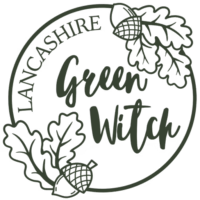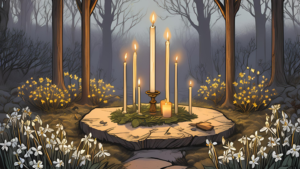What is Imbolc? A Celebration of the Returning Light and Spring’s First Stirrings
Imbolc is a sacred festival deeply rooted in Celtic and pagan traditions. It marks the midpoint between Yule and Ostara on the Wheel of the Year, symbolising the return of light and the first signs of spring. Celebrated on February 1st or 2nd, this festival honours renewal, inspiration, and the goddess Brigid. Let’s dive into the magic and meaning of Imbolc, exploring its history, rituals, and modern-day relevance.
The Origins and History of Imbolc
Imbolc, derived from the Old Irish word imbolg, meaning “in the belly,” hints at the stirring of new life within the earth. Historically, this festival was celebrated by the ancient Celts to honour the transition from the dark, cold days of winter to the promise of warmth and growth. As the days lengthen, Imbolc represents hope, renewal, and preparation for the abundance of spring.
Central to Imbolc is the veneration of Brigid, the Celtic goddess of poetry, healing, and smithcraft. As a deity of fire and fertility, Brigid embodies the light and life emerging during this season. In later times, Brigid was syncretised with Saint Brigid in Christian traditions, but her pagan roots remain strong among modern witches and pagans.
Why Imbolc is Significant on the Wheel of the Year
The Wheel of the Year is a cyclical calendar marking seasonal changes and key pagan festivals. Imbolc holds a unique place as the midpoint between the winter solstice (Yule) and the spring equinox (Ostara). This transitional period encourages reflection on the growth to come while acknowledging the strength gained during winter’s challenges.
Imbolc’s symbolism extends beyond the physical signs of spring. Spiritually, it signifies inner awakening and the spark of inspiration. Just as the earth begins to stir beneath the frost, Imbolc invites us to nurture our dreams and intentions, planting seeds for future growth.
How to Celebrate Imbolc
There are countless ways to honour Imbolc, whether through traditional rituals or modern interpretations. Here are some ideas to incorporate into your practice:
1. Light Candles to Symbolise Returning Light
Imbolc is a festival of fire, making candles a powerful symbol. Light candles throughout your home or during your rituals to represent the growing sunlight. Consider crafting your own candles infused with herbs like rosemary or lavender to enhance the energy of renewal.
2. Honour the Goddess Brigid
Create an altar dedicated to Brigid, adorned with:
- Red, white, or gold candles
- A small bowl of milk or cream (a traditional offering)
- Symbols of her domains, such as poetry books, healing herbs, or small tools for crafting
Recite prayers or poems to connect with her energy, asking for guidance and inspiration in the months ahead.
3. Perform a Cleansing Ritual
Spring cleaning is not just a practical task but a sacred act during Imbolc. Cleanse your home and magical tools with purifying herbs like sage or cedar. Sweep away stagnant energy to make space for growth and creativity.
4. Celebrate with Seasonal Foods
Incorporate traditional foods like dairy products, root vegetables, and grains into your Imbolc feast. Here are some ideas:
- Warm oat or barley soup
- Freshly baked bread
- Cheese platters
- Milk or cream-based desserts
Sharing a meal with loved ones enhances the communal spirit of this celebration.
5. Plant Seeds—Literally or Figuratively
If weather permits, start planting early seeds in your garden. Alternatively, focus on setting intentions for the year. Write down your goals, dreams, and aspirations on paper, then symbolically “plant” them by burying the paper in the soil or keeping it on your altar.
6. Make a Brigid’s Cross
Crafting a Brigid’s Cross from straw, wheat, or even paper is a traditional Imbolc activity. Hang this sacred symbol in your home for protection and blessings throughout the year.
The Mystical Correspondences of Imbolc
Imbolc is rich with correspondences that enhance your rituals and spells. Here are some key elements to incorporate:
- Colours: White, gold, red, green
- Crystals: Amethyst, garnet, citrine
- Herbs: Basil, rosemary, lavender
- Elements: Fire and water
Aligning your magical tools and practices with these correspondences amplifies your connection to Imbolc’s energy.
Modern-Day Relevance of Imbolc
In today’s fast-paced world, Imbolc offers a moment to pause and realign with nature’s rhythms. Its themes of light, renewal, and hope are universally resonant, reminding us of the cyclical nature of life and the importance of patience and preparation.
For modern witches and pagans, Imbolc serves as a time to:
- Reignite creative projects
- Reconnect with the divine feminine
- Celebrate small victories and incremental progress
Even those who don’t identify as spiritual can find meaning in the themes of Imbolc, such as fostering resilience and embracing the potential for growth.
Imbolc Ritual for Beginners
Here is a simple Imbolc ritual for those new to celebrating the Wheel of the Year:
Materials:
- A white candle
- A small bowl of water
- A pen and paper
Steps:
- Light the candle and focus on its flame, visualising the returning light and warmth.
- Reflect on what you want to nurture in your life. Write down your intentions or goals.
- Dip your fingers in the water and sprinkle it around your space, saying: “I cleanse this space and welcome the light of Imbolc.”
- Burn the paper with your intentions in the candle flame (safely), symbolising your commitment to growth.
Internal and External Links for Further Exploration
- Internal: The Wheel of the Year: A Beginner’s Guide | Yule: Embracing Winter’s Stillness | Ostara: Welcoming the Spring Equinox
- External: Learn More About Brigid | Seasonal Foods for Imbolc

